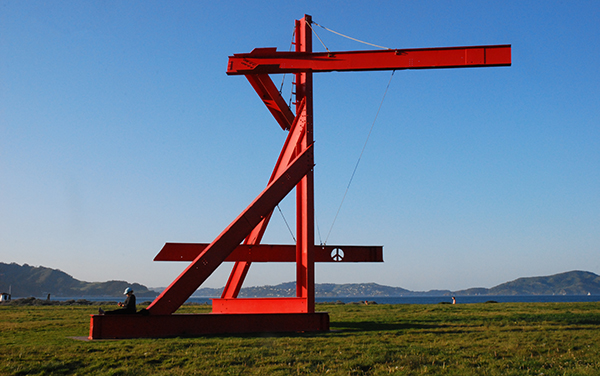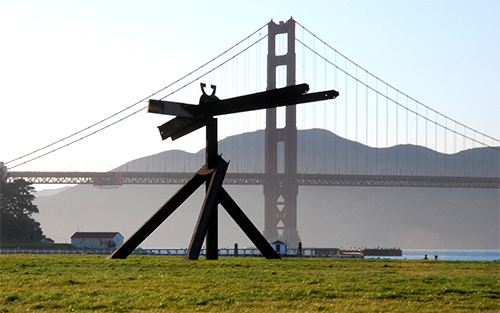Mark di Suvero at Crissy Field, San Francisco
A review of Mark di Suvero at Crissy Fields, San Francisco
By Gracie Linden

Currently eight of Mark di Suvero’s monumental sculptures are on view at San Francisco’s Crissy Field for the inaugural exhibition of San Francisco Museum of Modern Art’s year of external programming. In partnership with the National Parks Service and Golden Gate Parks Conservancy, SFMOMA has united these enormous steel works made over the course of five decades. Di Suvero himself is tied to San Francisco: Born in Shanghai China to Italian parents, he moved to San Francisco at the age of 8 with his father and stayed in California until he finished his degree at the University of California, Berkeley. After graduating, his first jobs were in construction, a clear influence on his sculptures, which incorporate structural steel, railroad ties, I-beams and heavy gauge metal.

Traditionally, sculpture was a means to commemorate, using a symbolic language in order to memorialize a particular person or place. Modernism introduced a new conceptual framework, in which the sculpture became a tribute to itself and, by making its mode of construction apparent, a sculpture’s identity became self-referential. As Rosalind Kruass wrote, “Through the presentation of its own materials or the process of its construction, the sculpture depicts its own autonomy.” Modernist sculpture honors neither event nor historic figure, but rather material and practice. As such, characterization turns inward: form begins to govern all.
While di Suvero’s works may be viewed collectively, each in reality exists entirely unto itself. Brought together after decades of installation in other cities and states, these sculptures neither need Crissy Field nor even each other, and their own histories are of secondary importance. Although each uses Crissy Field as a pedestal, merging directly with the land, the works are not monuments to the history of the park, or even the city. They feel almost outside linear time. His Mother Peace (1970) made in protest to the Vietnam War, was first installed in Oakland, but was later acquired by the Storm King Sculpture Park in New York; this is its first return to the Bay Area since 1974.

The greatest flaw of the installation, however, is the fact that it sits at the foot of the Golden Gate Bridge, an overwhelming representation of modernity and innovation; di Suvero’s works are made into small, minor steel groupings in the shadow of an actual monument. To view the bridge is to view the history of the city, and this expanse, both geographically and temporally, is awe-inspiring. In comparison, di Suvero’s sculptures – their rusty reds riffing off of the bridge’s patented International Orange – seem like piles of scrap metal.
Looking east however, with one’s back to the bridge, allows for a more nuanced understanding of di Suvero’s works specifically and art in the city more broadly. San Francisco, at its core, is defined by the contemporary and from this vantage point di Suvero’s installation feels like an ode to progress and industry, unencumbered by the past. The sculptures seem lighthearted, playing off of the buildings, off of technological innovation, off of the shifting spirit of the city. In short, they are fresh: autonomous, future-oriented entities with malleable identities.
Learn more about the exhibition on the SF MOMA website.
Grace Linden recently completed her Master's degree in History of Art at the University of Oxford. Currently, she works for the For-Site Foundation in San Francisco.